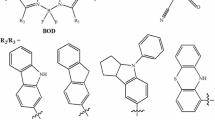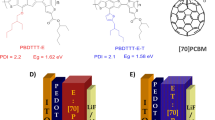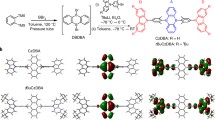Abstract
A molecular dyad, comprising two disparate extended boron dipyrromethene (BODIPY) units, has been identified as a potential component of artificial light-harvesting arrays. Highly efficient, intramolecular electronic energy transfer takes place under illumination but there is some competition from light-induced electron transfer along the molecular axis. The primary energy acceptor has a somewhat shortened excited-state lifetime and reduced emission quantum yield due to charge transfer from a terminal amine residue, the latter being required for the molecular system to operate in organic solar cells. Under continuous illumination with simulated solar light, the dyad undergoes very slow decomposition. In a protic solvent, both BODIPY units degrade at the same rate via an autocatalytic process. The products, one of which is a protonated analogue of the donor, degrade further by independent routes. In aprotic solvents or thin plastic films, the acceptor BODIPY dye absorbing at lowest energy undergoes photochemical degradation as above but the donor is much more stable under these conditions. At each stage of degradation, the molecule retains the ability to sensitize an amorphous silicon solar cell and the overall turnover number with respect to absorbed photons exceeds 10 million. The optical properties of the target compound nicely complement those of the solar cell and sensitization helps to avoid Staebler–Wronski photo-degradation.
Similar content being viewed by others
Notes and references
D. Beljonne, C. Curutchet, G. D. Scholes and R. J. Silbey, Beyond Förster resonance energy transfer in biological and nanoscale systems, J. Phys. Chem. B, 2009, 113, 6583–6599.
J. S. Wu, W. M. Liu, J. C. Ge, H. Y. Zhang and P. F. Wang, New sensing mechanisms for design of fluorescent chemosensors emerging in recent years, Chem. Soc. Rev., 2011, 40, 3483–3495.
C. H. Fan, K. W. Plaxco and A. J. Heeger, Biosensors based on binding-modulated donor-acceptor distances, Trends Biotechnol., 2005, 23, 186–192.
V. Balzani, Photochemical molecular devices, Photochem. Photobiol. Sci., 2003, 2, 459–476.
R. Ziessel and A. Harriman, Artificial light-harvesting antennae: Electronic energy transfer by way of molecular funnels, Chem. Commun., 2011, 47, 611–631.
A. C. Benniston, A. Harriman and S. Yang, Providing power for miniaturized medical implants: Triplet sensitization of semiconductor surfaces, Philos. Trans. R. Soc. London, A, 2013, 371, 20120334.
R. Ziessel, G. Ulrich, A. Haefele and A. Harriman, An artificial light-harvesting array constructed from multiple Bodipy dyes, J. Am. Chem. Soc., 2013, 135, 11330–11344.
B. A. Gregg, Excitonic solar cells, J. Phys. Chem. B, 2003, 107, 4688–4698.
G. Ulrich, R. Ziessel and A. Harriman, The chemistry of fluorescent Bodipy dyes: Versatility unsurpassed, Angew. Chem., Int. Ed., 2008, 47, 1184–1201.
A. Klaver, R. A. van Swaaij, Modelling of light-induced degradation of amorphous silicon solar cells, Sol. Energy Mater. Sol. Cells, 2008, 92, 50–60.
N. Boens, V. Leen and W. Dehaen, Fluorescent indicators based on BODIPY, Chem. Soc. Rev., 2012 41, 130–1172.
A. Nano, P. Retailleau, J. P. Hagon, A. Harriman and R. Ziessel, A hybrid bis(amino-styryl) substituted Bodipy dye and its conjugate diacid: Synthesis, structure, spectroscopy and quantum chemical calculations, Phys. Chem. Chem. Phys., 2014 16, 10187–10198.
J. R. Bolton and M. D. Archer, Calculation of natural radiative lifetimes from absorption and fluorescence properties of semiconductors and molecules, J. Phys. Chem., 1991, 95, 8453–8461.
T. Bura, N. Leclerc, S. Fall, P. Leveque, T. Heiser, P. Retailleau, S. Rihn, A. Mirloup and R. Ziessel, High-performance solution-processed solar cells and ambipolar behavior in organic field effect transistors with thienyl-BODIPY scaffolding, J. Am. Chem. Soc., 2012, 134, 17404–17407.
A. Harriman, G. Izzet and R. Ziessel, Rapid energy transfer in cascade-type Bodipy dyes, J. Am. Chem. Soc., 2006, 128, 10868–10875.
R. E. Dale, J. Eisinger and W. E. Blumberg, Orientational freedom of molecular probes - orientation factor in intramolecular energy transfer, Biophys. J., 1979, 26, 161–193.
P. G. Wu and L. Brand, Resonance energy transfer–methods and applications, Anal. Biochem., 1994, 218, 1–13.
V. Czikklely, H. D. Forsterling and H. Kuhn, Extended dipole model for aggregates of dye molecules, Chem. Phys. Lett., 1970, 6, 207–210.
R. Ziessel, P. Retailleau, K. J. Eliott and A. Harriman, Boron dipyrrin dyes exhibiting push–pull-push electronic signatures, Chem.–Eur. J., 2009, 15, 10369–10374.
M. R. Wasielewski, Photoinduced electron-transfer in supramolecular systems for artificial photosynthesis, Chem. Rev., 1992, 92, 435–461.
F. Mata-Perez, J. F. Perez-Benito, The kinetic rate law for autocatalytic reactions, J. Chem. Educ., 1987, 64, 925–927.
O. M. Usov, M. I. Bardamova and I. L. Kotlyarevskii, Photochemistry of acetylenic derivatives of aromatic amines. 1. Photolysis products of paraethynyl-N,N-dimethylaniline in carbon tetrachloride, Bull. Acad. Sci. USSR Div. Chem. Sci., 1086 35, 1055–1057.
M. I. Bardamova and O. M. Usov, Photochemistry of acetylenic derivatives of aromatic amines. 2. Photolysis of para-ethynyl-N,N-dibenzylaniline and para-butadiynyl-N,N-dibenzyl-aniline in the presence of carbon tetrachloride and oxygen, Bull. Acad. Sci. USSR Div. Chem. Sci., 1086 35, 1055–1057.
Z. B. Alfassi, A. Harriman, S. Mosseri and P. Neta, Rates and mechanisms of oxidation of ZnTPP by CCl3O2 radicals in various solvents, Int. J. Chem. Kinet., 1986, 18, 1315–1321.
H. D. Burrows, T. J. Kemp and D. Greatore, Solute radical cation yields in pulse radiolysis of solutions of aromatic amines in chlorinated hydrocarbons, J. Phys. Chem., 1972 76, 20–27.
H. D. Burrows, T. J. Kemp and M. J. Welbourn, Intermediates in the pulse radiolysis of solutions of phenothiazine and its derivatives - Reactions of cycloalkylperoxyl radicals with phenothiazines, J. Chem. Soc., Perkin Trans. 2, 1973, 969–974.
S. Wennmalm and R. Rigler, On death numbers and survival times of single dye molecules, J. Phys. Chem. B, 1999, 103, 2516–2519.
H. S. Weerasinghe, S. E. Watkins, N. Duffy, D. J. Jones and A. D. Scully, Influence of moisture out-gassing from encapsulant materials on the lifetime of organic solar cells, Sol. Energy Mater. Sol. Cells, 2015, 132, 485–491.
A. A. Pascal, Z. F. Liu, K. Broess, B. van Oort, H. van Amerongen, C. Wang, P. Horton, B. Robert, W. R. Chang and A. Ruban, Molecular basis of photoprotection and control of photosynthetic light-harvesting, Nature, 2005 436, 134–137.
G. Peers, T. B. Truong, E. Ostendorf, A. Busch, D. Elrad, A. R. Grossman, M. Hippler and K. K. Niyogi, An ancient light-harvesting protein is critical for the regulation of algal photosynthesis, Nature, 2009 462, 518–522.
H. R. Bolharnordenkampf, M. Hofer and E. G. Lechner, Analysis of light-induced reduction of the photochemical capacity in field-grown plants–evidence for photoinhibition, Photosynth. Res., 1991, 27, 31–39.
P. Horton, A. V. Ruban and M. Wentworth, Allosteric regulation of the light-harvesting system of photosystem II, Philos. Trans. R. Soc. London, Ser. B, 2000, 355, 1361–1370.
R. Ahlrichs, M. Bär, M. Häser, H. Horn, C. Kölmel, Electronic structure calculations on workstation computers: The program system Turbomole, Chem. Phys. Lett., 1989, 162, 165–169.
V. Barone and M. Cossi, J. Phys. Chem. A, 1998 102, 1995–2001.
H. Li and J. H. Jensen, J. Comput. Chem., 2004 25, 1449–1456.
R. Ziessel, S. Rihn and A. Harriman, Quasi-one-dimensional electronic systems formed from boron dipyrromethene (BODIPY) dyes, Chem.–Eur. J., 2010, 16, 11942–11953.
A. Sutter and R. Ziessel, A versatile synthesis of long-wavelength-excitable BODIPY dyes from readily modifiable cyclopenta[2,1-b:3.4-b]dithiophenes, Synlett, 2014, 1466–1472.
Author information
Authors and Affiliations
Corresponding authors
Additional information
Electronic supplementary information (ESI) available: Spectroscopic characterization of new compounds, energy-minimized structures for A1, D1 and 1, details for estimation of ?GCT, version of Fig. 5 showing reaction times, spectra showing photo-conversion of A1. See DOI: 10.1039/c5pp00021a
Rights and permissions
About this article
Cite this article
Harriman, A., Stachelek, P., Sutter, A. et al. Stepwise photoconversion of an artificial light-harvesting array built from extended BODIPY units. Photochem Photobiol Sci 14, 1100–1109 (2015). https://doi.org/10.1039/c5pp00021a
Received:
Accepted:
Published:
Issue Date:
DOI: https://doi.org/10.1039/c5pp00021a




